人教版(2019)高中英语选择性必修第二册 Unit5First Aid Using Language—Writing 优质课件(共30张PPT)
文档属性
| 名称 | 人教版(2019)高中英语选择性必修第二册 Unit5First Aid Using Language—Writing 优质课件(共30张PPT) | 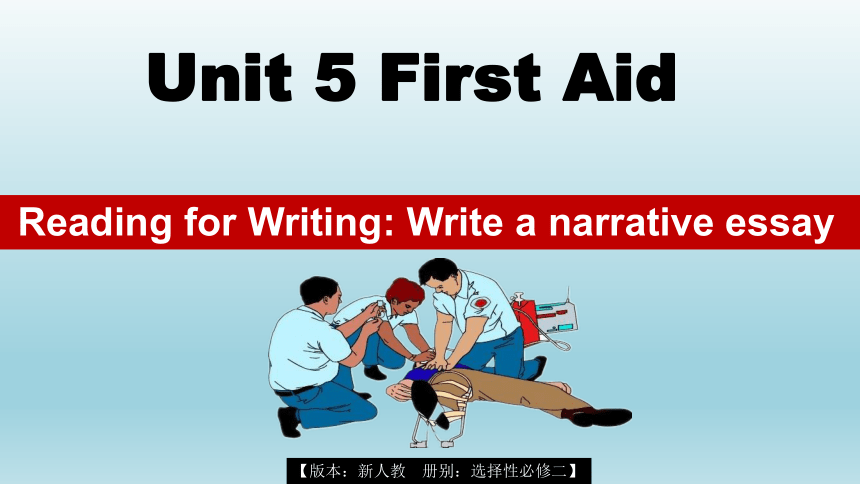 | |
| 格式 | pptx | ||
| 文件大小 | 11.3MB | ||
| 资源类型 | 教案 | ||
| 版本资源 | 人教版(2019) | ||
| 科目 | 英语 | ||
| 更新时间 | 2023-03-12 20:05:46 | ||
图片预览

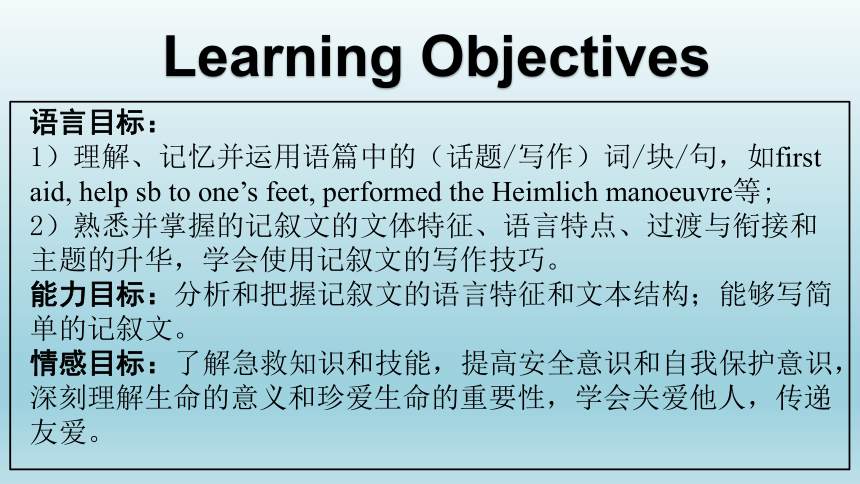
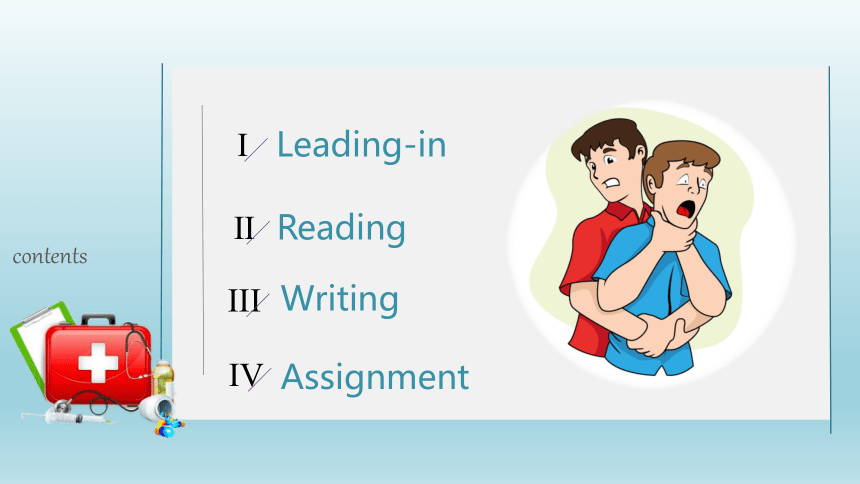

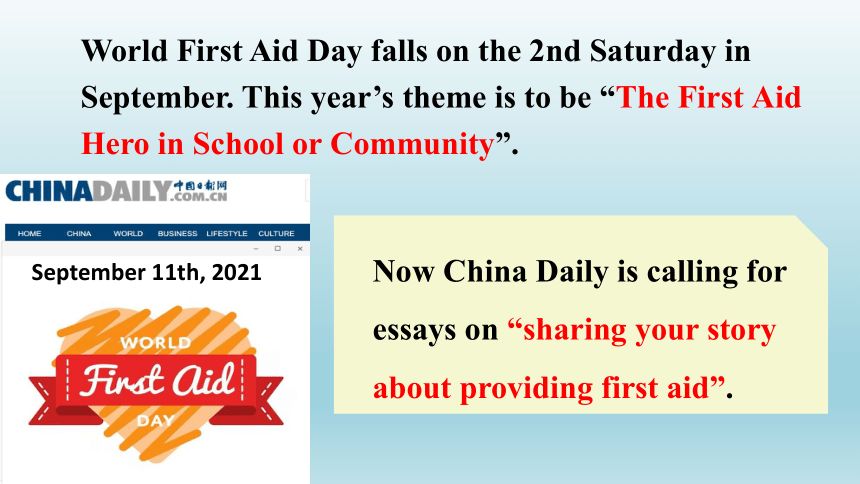
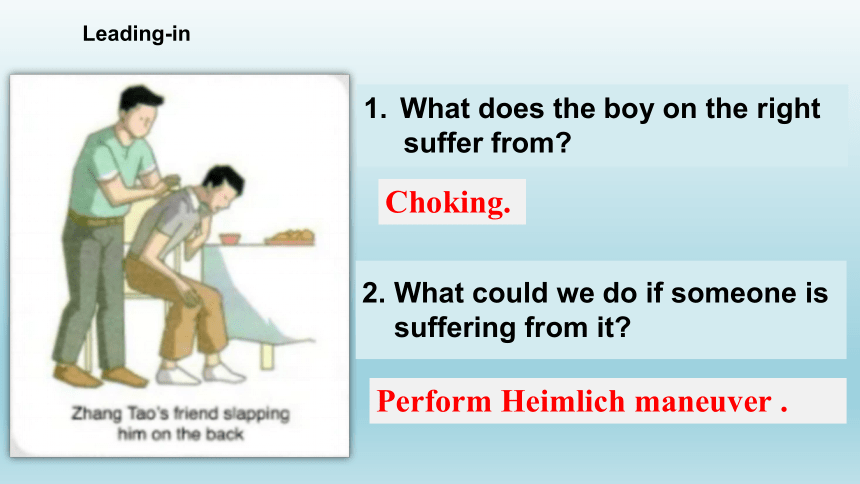

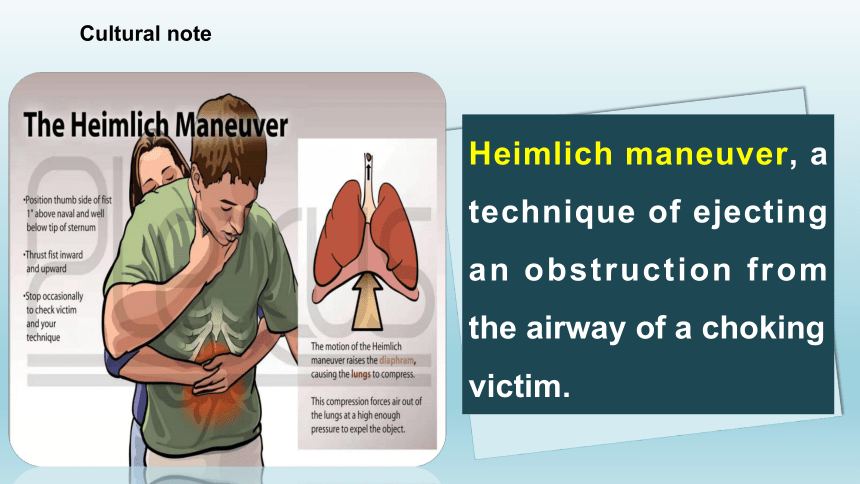
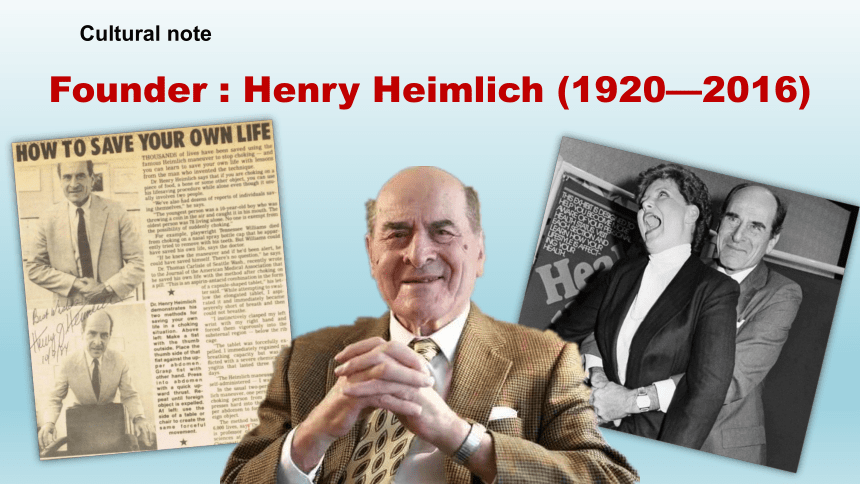

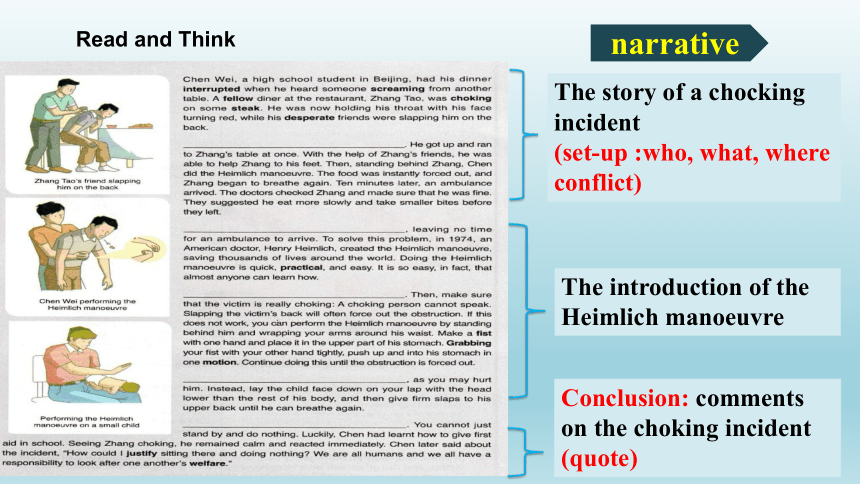

文档简介
(共30张PPT)
Reading for Writing: Write a narrative essay
Unit 5 First Aid
【版本:新人教 册别:选择性必修二】
Learning Objectives
语言目标:
1)理解、记忆并运用语篇中的(话题/写作)词/块/句,如first aid, help sb to one’s feet, performed the Heimlich manoeuvre等;
2)熟悉并掌握的记叙文的文体特征、语言特点、过渡与衔接和主题的升华,学会使用记叙文的写作技巧。
能力目标:分析和把握记叙文的语言特征和文本结构;能够写简单的记叙文。
情感目标:了解急救知识和技能,提高安全意识和自我保护意识,深刻理解生命的意义和珍爱生命的重要性,学会关爱他人,传递友爱。
contents
Leading-in
Ⅰ
Writing
Reading
Ⅱ
Assignment
III
Ⅳ
I
Leading-in
World First Aid Day falls on the 2nd Saturday in September. This year’s theme is to be “The First Aid Hero in School or Community”.
Now China Daily is calling for essays on “sharing your story about providing first aid”.
September 11th, 2021
What does the boy on the right
suffer from
2. What could we do if someone is
suffering from it
Choking.
Perform Heimlich maneuver .
Leading-in
Heimlich maneuver
Cultural note
Heimlich maneuver, a technique of ejecting an obstruction from the airway of a choking victim.
Cultural note
Founder : Henry Heimlich (1920—2016)
Ⅱ
Reading
narrative
The story of a chocking incident
(set-up :who, what, where conflict)
The introduction of the Heimlich manoeuvre
Conclusion: comments on the choking incident
(quote)
Read and Think
Chen Wei, a high school student in Beijing, had his dinner interrupted when he heard someone screaming from another table. A fellow diner at the restaurant, Zhang Tao, was choking on some steak. He was now holding his throat with his face turning red, while his desperate friends were slapping him on the back.
______________________________________________________________________
The First Aid Hero in School:
Heimlich Maneuver Can Save A Man's Life
____________________. He got up and ran to Zhang’s table at once. With the help of Zhang’s friends, he was able to help Zhang to his feet. Then, standing behind Zhang, Chen did the Heimlich manoeuvre. The food was instantly forced out,and Zhang began to breathe again. Ten minutes later, an ambulance arrived. The doctors checked Zhang and made sure that he was fine. They suggested he
Chen wasted no time.
transitional sentence: link up ideas between paragraphsa
in the first or third person
in active voice
simple past tense
Read and Think (Students’ Worksheet 1)
your arms around his waist. Make a fist with one hand and place it in the upper part of his stomach. Grabbing your fist with your other hand tightly, push up and into his stomach in one motion. Continue doing this until the obstruction is forced out.
_______________________________________________________________________, as you may hurt him. Instead, lay the child face down on your lap with the head lower than the rest of his body, and then give firm slaps to his upper back until he can breathe again.
Doing the Heimlich manoeuvre on a small child is not recommended
transitional sentence
Read and Think (Students’ Worksheet 1)
_____________________________________________. You cannot just stand by and do nothing. Luckily, Chen had learnt how to give first aid in school.Seeing Zhang choking, he remained calm and reacted immediately. Chen later said about the incident,“____________________________________________________________________________________________________________________________________.”
We are all humans and we all have a responsibility to look after one another’s welfare.
With choking victims, every minute counts.
How could I justify sitting there and doing nothing
a quote to sum up
give unique insight in his character
transitional sentence
Read and Think (Students’ Worksheet 1)
Chen Wei, a high school student in Beijing, had his dinner interrupted when he heard someone screaming from another table. A fellow diner at the restaurant, Zhang Tao, was choking on some steak. He was now__________________(手按着喉咙) _______________________(满脸通红), while his desperate friends were________________________ (拍他的背).
Chen ________________(毫不迟疑). He got up and ran to Zhang’s table at once. With the help of Zhang’s friends, he was able to _________________________
(扶着他站起来). Then, standing behind Zhang, Chen did the Heimlich manoeuvre. The food was instantly forced out, and Zhang began to breathe again.
holding his throat
with his face turning red
slapping him on the back
wasted no time
helping Zhang to his feet
Read and Find (Students’ Worksheet 2)
Ten minutes later, an ambulance arrived. The doctors checked Zhang and made sure that he was fine. They suggested he eat more slowly and take smaller bites before they left.
Choking victims usually have only about four minutes before they collapse and sometimes die, ________(leave)no time for an ambulance to arrive. To solve this problem, in 1974, an American doctor, Henry Heimlich, created the Heimlich manoeuvre, _______ (save)thousands of lives around the world. Doing the Heimlich manoeuvre is quick, practical, and easy. It is so easy, in fact, that almost anyone can learn how.
leaving
saving
Read and Find (Students’ Worksheet 2)
If you see someone choking, first call the emergency services. Then make sure that the victim is really choking: A choking person cannot speak. Slapping the victim’s back will often force out the obstruction. If this does not work, you can perform the Heimlich manoeuvre by _____________________(站在此人身后) and __________________________________(用双臂环抱其腰部). Make a fist with one hand and place it in the upper part of his stomach. Grabbing your fist with your other hand tightly, push up and into his stomach in one motion. Continue doing this until the obstruction is forced out.
standing behind him
wrapping your arms around his waist
Read and Find (Students’ Worksheet 2)
________ (do) the Heimlich manoeuvre on a small child is not recommended. Instead, lay the child face down on your lap with the head lower than the rest of his body, and then give firm slaps to his upper back until he can breathe again.
With choking victims, every minute counts. You cannot just stand by and do nothing. Luckily, Chen had learnt how to give first aid in school. Seeing Zhang choking, he remained calm and reacted immediately. Chen later said about the incident, “How could I justify sitting there and doing nothing We are all humans and we all have a responsibility to look after one another's welfare. "
Doing
Read and Find (Students’ Worksheet 2)
Writing
Ⅲ
Writing task
September 11th, 2021
World First Aid Day falls on the 2nd Saturday in September. This year’s theme is to be “The First Aid Hero in School or Community”. Now China Daily is calling for essays on “sharing your story about providing first aid”.
________________________________________________________________________________________________
Brainstorm: How to write a good narrative essay
A good narrative
essay
Set-up:
(introduce who/what/where)
Conflict:
(involve a challenge/difficulty)
Conclusion:
summary (evaluation/quote)
v-ing form
first aid
Heimlich manoeuvre
waste no time
slap sb on the back
help sb to one’s feet…
in the first or third person
in active voice
in simple past tense
Useful expressions
Language features
structure
grammar
The First Aid Hero in Community
The set-up:
The conflict(s):
Conclusion:
Who were the people involved
What happened
Where did it happen
Wanted to see the movie
Should we help
The man was not breathing
Was he alive
Could he be saved
Could I remember my training
Would it work
“It's a great honor to save a life. It's also a great honor to pay it forward.”
Revise the draft (Students’ Worksheet3)
Finally, we had a chance to see ‘Pay it Forward’. My friend Mary and I were on our way to the cinema to see a movie we had talked about for ages. Almost there, we saw an old man ________(sit) on the pavement outside the hot-pot restaurant.___________________________.
The First Aid Hero in Community:
_______________________
Pay it Forward
sitting
He looked in distress.
The set-up
Who:
Mary , I and an oldman
What:
to see a movie
Where:
in community
I wanted to help him, but Mary thought he might just be drunk and we would be late to see the movie. I really could not ignore the fact that he may be in trouble and I also had recently finished a first-aid course. ________________________________________
______________________.
The man was almost unconcious. He was__________________
____________________ (手按着喉咙满脸通红). I spoke to him but he could not speak. I opened his mouth but could see no obstructions.________________________________.
I tried hard to remember my recent training. ________(try) hard to recall the Heimlich manoeuvre, I ______________________. ___________________,_______________________________________________________________________
We wasted no time and decided to see what
was the matter with him.
holding his throat
with face turning red
I slapped him on the back. Nothing.
Trying
helped him to his feet
Standing behind him
I wrapped my arms around his waist
and performed the Heimlich manoeuvre.
The conflict(s)
Wanted to see the movie
Should we help
The man was not breathing
Was he alive
Could he be saved
Could I remember my training
Would it work
Revise the draft (Students’ Worksheet3)
The man coughed and spat out a large lump of food. We stayed with him as he recovered from the shock. We had of course missed the movie but I was pleased that I had been able to use my training to save someone’s life. A few days later, we received a VIP season pass to the cinema from the grateful man. I could not help _________(think) about the quote our teacher at the first aid school had kept using “____________________________________________
___________________________________________.”
thinking
It’s a great honor to save a life. It's also a great honor to pay it forward.
Conclusion
The man was saved. We got a season ticket for the cinema.
“It’s a great honor to save a life. It’s also a great honor to pay it forward.”
Revise the draft (Students’ Worksheet3)
Sample Writing
The First Aid Hero in Community:
Pay it Forward
Finally, we had a chance to see ‘Pay it Forward’. My friend Mary and I were on our way to the cinema to see a movie we had talked about for ages. Almost there, we saw an old man sitting on the pavement outside the hot-pot restaurant. He looked in distress.
I wanted to help him, but Mary thought he might just be drunk and we would be late to see the movie. I really could not ignore the fact that he may be in trouble and I also had recently finished a first-aid course. We wasted no time and decided to see what was the matter with him.
The man was almost unconscious. He was holding his throat with face turning red. I spoke to him but he could not speak. I opened his mouth but could see no obstructions. I slapped him on the back. Nothing.
I tried hard to remember my recent training. Trying hard to recall the Heimlich manoeuvre, I helped him to his feet. Standing behind him, I wrapped my arms around his waist and performed the Heimlich manoeuvre.
The man coughed and spat out a large lump of food. We stayed with him as he recovered from the shock. We had of course missed the movie but I was pleased that I had been able to use my training to save someone’s life. A few days later, we received a VIP season pass to the cinema from the grateful man. I could not help thinking about the quote our teacher at the first aid school had kept using “It’s a great honor to save a life. It’s also a great honor to pay it forward.”
Sample Writing
Assignment
Ⅳ
1.Recite the narrative story of “Pay it forward” Possible version One.
*2. Optional assignment:
Write your experiences of giving first aid in an
emergency or think up a situation based on
activity 6 on page 55.
Reading for Writing: Write a narrative essay
Unit 5 First Aid
【版本:新人教 册别:选择性必修二】
Learning Objectives
语言目标:
1)理解、记忆并运用语篇中的(话题/写作)词/块/句,如first aid, help sb to one’s feet, performed the Heimlich manoeuvre等;
2)熟悉并掌握的记叙文的文体特征、语言特点、过渡与衔接和主题的升华,学会使用记叙文的写作技巧。
能力目标:分析和把握记叙文的语言特征和文本结构;能够写简单的记叙文。
情感目标:了解急救知识和技能,提高安全意识和自我保护意识,深刻理解生命的意义和珍爱生命的重要性,学会关爱他人,传递友爱。
contents
Leading-in
Ⅰ
Writing
Reading
Ⅱ
Assignment
III
Ⅳ
I
Leading-in
World First Aid Day falls on the 2nd Saturday in September. This year’s theme is to be “The First Aid Hero in School or Community”.
Now China Daily is calling for essays on “sharing your story about providing first aid”.
September 11th, 2021
What does the boy on the right
suffer from
2. What could we do if someone is
suffering from it
Choking.
Perform Heimlich maneuver .
Leading-in
Heimlich maneuver
Cultural note
Heimlich maneuver, a technique of ejecting an obstruction from the airway of a choking victim.
Cultural note
Founder : Henry Heimlich (1920—2016)
Ⅱ
Reading
narrative
The story of a chocking incident
(set-up :who, what, where conflict)
The introduction of the Heimlich manoeuvre
Conclusion: comments on the choking incident
(quote)
Read and Think
Chen Wei, a high school student in Beijing, had his dinner interrupted when he heard someone screaming from another table. A fellow diner at the restaurant, Zhang Tao, was choking on some steak. He was now holding his throat with his face turning red, while his desperate friends were slapping him on the back.
______________________________________________________________________
The First Aid Hero in School:
Heimlich Maneuver Can Save A Man's Life
____________________. He got up and ran to Zhang’s table at once. With the help of Zhang’s friends, he was able to help Zhang to his feet. Then, standing behind Zhang, Chen did the Heimlich manoeuvre. The food was instantly forced out,and Zhang began to breathe again. Ten minutes later, an ambulance arrived. The doctors checked Zhang and made sure that he was fine. They suggested he
Chen wasted no time.
transitional sentence: link up ideas between paragraphsa
in the first or third person
in active voice
simple past tense
Read and Think (Students’ Worksheet 1)
your arms around his waist. Make a fist with one hand and place it in the upper part of his stomach. Grabbing your fist with your other hand tightly, push up and into his stomach in one motion. Continue doing this until the obstruction is forced out.
_______________________________________________________________________, as you may hurt him. Instead, lay the child face down on your lap with the head lower than the rest of his body, and then give firm slaps to his upper back until he can breathe again.
Doing the Heimlich manoeuvre on a small child is not recommended
transitional sentence
Read and Think (Students’ Worksheet 1)
_____________________________________________. You cannot just stand by and do nothing. Luckily, Chen had learnt how to give first aid in school.Seeing Zhang choking, he remained calm and reacted immediately. Chen later said about the incident,“____________________________________________________________________________________________________________________________________.”
We are all humans and we all have a responsibility to look after one another’s welfare.
With choking victims, every minute counts.
How could I justify sitting there and doing nothing
a quote to sum up
give unique insight in his character
transitional sentence
Read and Think (Students’ Worksheet 1)
Chen Wei, a high school student in Beijing, had his dinner interrupted when he heard someone screaming from another table. A fellow diner at the restaurant, Zhang Tao, was choking on some steak. He was now__________________(手按着喉咙) _______________________(满脸通红), while his desperate friends were________________________ (拍他的背).
Chen ________________(毫不迟疑). He got up and ran to Zhang’s table at once. With the help of Zhang’s friends, he was able to _________________________
(扶着他站起来). Then, standing behind Zhang, Chen did the Heimlich manoeuvre. The food was instantly forced out, and Zhang began to breathe again.
holding his throat
with his face turning red
slapping him on the back
wasted no time
helping Zhang to his feet
Read and Find (Students’ Worksheet 2)
Ten minutes later, an ambulance arrived. The doctors checked Zhang and made sure that he was fine. They suggested he eat more slowly and take smaller bites before they left.
Choking victims usually have only about four minutes before they collapse and sometimes die, ________(leave)no time for an ambulance to arrive. To solve this problem, in 1974, an American doctor, Henry Heimlich, created the Heimlich manoeuvre, _______ (save)thousands of lives around the world. Doing the Heimlich manoeuvre is quick, practical, and easy. It is so easy, in fact, that almost anyone can learn how.
leaving
saving
Read and Find (Students’ Worksheet 2)
If you see someone choking, first call the emergency services. Then make sure that the victim is really choking: A choking person cannot speak. Slapping the victim’s back will often force out the obstruction. If this does not work, you can perform the Heimlich manoeuvre by _____________________(站在此人身后) and __________________________________(用双臂环抱其腰部). Make a fist with one hand and place it in the upper part of his stomach. Grabbing your fist with your other hand tightly, push up and into his stomach in one motion. Continue doing this until the obstruction is forced out.
standing behind him
wrapping your arms around his waist
Read and Find (Students’ Worksheet 2)
________ (do) the Heimlich manoeuvre on a small child is not recommended. Instead, lay the child face down on your lap with the head lower than the rest of his body, and then give firm slaps to his upper back until he can breathe again.
With choking victims, every minute counts. You cannot just stand by and do nothing. Luckily, Chen had learnt how to give first aid in school. Seeing Zhang choking, he remained calm and reacted immediately. Chen later said about the incident, “How could I justify sitting there and doing nothing We are all humans and we all have a responsibility to look after one another's welfare. "
Doing
Read and Find (Students’ Worksheet 2)
Writing
Ⅲ
Writing task
September 11th, 2021
World First Aid Day falls on the 2nd Saturday in September. This year’s theme is to be “The First Aid Hero in School or Community”. Now China Daily is calling for essays on “sharing your story about providing first aid”.
________________________________________________________________________________________________
Brainstorm: How to write a good narrative essay
A good narrative
essay
Set-up:
(introduce who/what/where)
Conflict:
(involve a challenge/difficulty)
Conclusion:
summary (evaluation/quote)
v-ing form
first aid
Heimlich manoeuvre
waste no time
slap sb on the back
help sb to one’s feet…
in the first or third person
in active voice
in simple past tense
Useful expressions
Language features
structure
grammar
The First Aid Hero in Community
The set-up:
The conflict(s):
Conclusion:
Who were the people involved
What happened
Where did it happen
Wanted to see the movie
Should we help
The man was not breathing
Was he alive
Could he be saved
Could I remember my training
Would it work
“It's a great honor to save a life. It's also a great honor to pay it forward.”
Revise the draft (Students’ Worksheet3)
Finally, we had a chance to see ‘Pay it Forward’. My friend Mary and I were on our way to the cinema to see a movie we had talked about for ages. Almost there, we saw an old man ________(sit) on the pavement outside the hot-pot restaurant.___________________________.
The First Aid Hero in Community:
_______________________
Pay it Forward
sitting
He looked in distress.
The set-up
Who:
Mary , I and an oldman
What:
to see a movie
Where:
in community
I wanted to help him, but Mary thought he might just be drunk and we would be late to see the movie. I really could not ignore the fact that he may be in trouble and I also had recently finished a first-aid course. ________________________________________
______________________.
The man was almost unconcious. He was__________________
____________________ (手按着喉咙满脸通红). I spoke to him but he could not speak. I opened his mouth but could see no obstructions.________________________________.
I tried hard to remember my recent training. ________(try) hard to recall the Heimlich manoeuvre, I ______________________. ___________________,_______________________________________________________________________
We wasted no time and decided to see what
was the matter with him.
holding his throat
with face turning red
I slapped him on the back. Nothing.
Trying
helped him to his feet
Standing behind him
I wrapped my arms around his waist
and performed the Heimlich manoeuvre.
The conflict(s)
Wanted to see the movie
Should we help
The man was not breathing
Was he alive
Could he be saved
Could I remember my training
Would it work
Revise the draft (Students’ Worksheet3)
The man coughed and spat out a large lump of food. We stayed with him as he recovered from the shock. We had of course missed the movie but I was pleased that I had been able to use my training to save someone’s life. A few days later, we received a VIP season pass to the cinema from the grateful man. I could not help _________(think) about the quote our teacher at the first aid school had kept using “____________________________________________
___________________________________________.”
thinking
It’s a great honor to save a life. It's also a great honor to pay it forward.
Conclusion
The man was saved. We got a season ticket for the cinema.
“It’s a great honor to save a life. It’s also a great honor to pay it forward.”
Revise the draft (Students’ Worksheet3)
Sample Writing
The First Aid Hero in Community:
Pay it Forward
Finally, we had a chance to see ‘Pay it Forward’. My friend Mary and I were on our way to the cinema to see a movie we had talked about for ages. Almost there, we saw an old man sitting on the pavement outside the hot-pot restaurant. He looked in distress.
I wanted to help him, but Mary thought he might just be drunk and we would be late to see the movie. I really could not ignore the fact that he may be in trouble and I also had recently finished a first-aid course. We wasted no time and decided to see what was the matter with him.
The man was almost unconscious. He was holding his throat with face turning red. I spoke to him but he could not speak. I opened his mouth but could see no obstructions. I slapped him on the back. Nothing.
I tried hard to remember my recent training. Trying hard to recall the Heimlich manoeuvre, I helped him to his feet. Standing behind him, I wrapped my arms around his waist and performed the Heimlich manoeuvre.
The man coughed and spat out a large lump of food. We stayed with him as he recovered from the shock. We had of course missed the movie but I was pleased that I had been able to use my training to save someone’s life. A few days later, we received a VIP season pass to the cinema from the grateful man. I could not help thinking about the quote our teacher at the first aid school had kept using “It’s a great honor to save a life. It’s also a great honor to pay it forward.”
Sample Writing
Assignment
Ⅳ
1.Recite the narrative story of “Pay it forward” Possible version One.
*2. Optional assignment:
Write your experiences of giving first aid in an
emergency or think up a situation based on
activity 6 on page 55.
